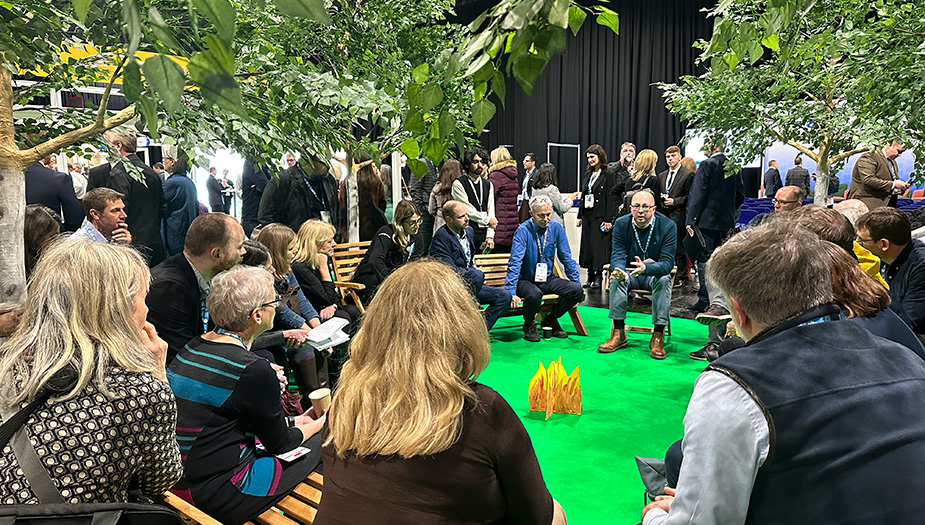Learning Places Scotland conference

How do we design, deliver and use outdoor learning spaces to demonstrate the right values, place qualities and needs of the planet, people and education?
At Architecture and Design Scotland, we believe in the power of collaborative design to deliver spaces and places that are better for people and the planet. Recently, in November 2023, we were at the two days of the Learning Places Scotland conference, exchanging examples and lessons on how the learning estate - from early years schools up to universities – can be designed and delivered, in partnership, to support place, climate and education outcomes.
This year, Architecture and Design Scotland delved deeper into place-based approaches and ‘how to’ adapt outdoor spaces to support learning and climate action. We shared the stage with a range of practitioners. Underpinning all of these projects is a whole place and collaborative approach.
Nature and nurture
Kath McTaggart, Landscape Architect, BDP looked at local distinctiveness, historic stories, archaeology, geology, how people are using the landscapes, and workshops with young people to inform creating special places. Nature and nurture were both created through green infrastructure, places to learn and play in distinctive playground landscapes that are interpreted by the young people who use them. In each of these school they have tried to have rain gardens and tree planting with 17,000 trees planted in the last few years.
Digital and natural
Felicity Steers, Director of erz began with the provocations that landscape is more important than architecture, and that as we go more digital, we probably need to go more natural at the same time. She mentioned the good news story that policies, including the National Planning Framework (NPF4), are in our favour and changing towards everything we build having to enhance biodiversity – so harnessing the power of policy to enable and deliver good infrastructure and places.
An invitational space –join in and play
Patrick Boxall Lecturer in Initial Teacher Education at Queen Margaret University talked about the further education environment and QMU’s outdoor learning hub. A multi-purpose, active space that is not just a classroom, bringing value and purpose by improving the life of students and connecting to communities. At QMU outdoor learning is built into the curriculum for all teachers and educators, linking into wider learning in Scotland and the outdoor learning research group.
The message again was towards global thinking and the balance between the natural and the technological world.
Outdoor spaces of poor areas for biodiversity, learning and play
Matt Robinson, Scotland Director of Learning through Landscape presented the partnership work with Architecture and Design Scotland on developing the Climate Ready School Ground initiative. He shared that the school estate in Scotland covers an area the size of Dundee city, with most of the outdoor spaces being hard surfaced or maintained grasses.
He highlighted that these spaces do little to mitigate the impacts of climate change, and are poor areas for biodiversity, learning and play. Matt shared examples of the practical suite of tools, aimed at two different audiences - Designers and Facilities Managers, as well as teachers and pupils which have been co-developed by Learning through Landscape and Architecture and Design Scotland.
Working with Architecture and Design Scotland has brought that view that’s much wider than we would get if it was just one landscape or one project – that overview of what’s happening in Scotland, the great projects that there are the forthcoming challenges, being able to look across a group of organisations, rather than just working with one organisation is fantastic. And I think Architecture and Design Scotland puts themselves forward for the benefit of us all, which has really helped.
Drivers for change
Overall, the Learning Places Scotland conference put a fresh perspective on an established principle - ‘where our children [and adults] learn matters’. The different sessions outlined above, emphasised the importance of the learning environment.
Research presented at the conference revealed that young people are currently spending minimal time learning outdoors, and a considerable portion of school grounds consists of tarmac or mown grass. Traditionally, the focus has been on designing the building first, with outdoor spaces considered later. Despite policy support for outdoor learning and efforts to address climate and nature concerns, progress has been slow.
Call to Action
To address these challenges, it is crucial to involve landscape architects from the beginning of the collaborative design process. This approach ensures that education spaces are intentionally designed to promote and facilitate outdoor learning experiences, aligning with policy objectives and creating engaging and effective learning environments for all.
Additionally, it is important to consider the local distinctiveness of learning spaces, integrating schools into the community and vice versa. This fosters connections between people, nature, and place, while involving the wider community in the design process helps establish a sense of place identity.
Furthermore, school grounds offer significant opportunities for climate adaptation. Resources such as the climate-ready school grounds can help identify opportunities. By considering climate adaptation in the design process, education spaces can contribute to addressing climate challenges.
Overall, a collaborative design process involving landscape architects, considering local distinctiveness, and addressing climate adaptation can help create learning environments that support outdoor learning, foster community connections, and contribute to addressing the climate and nature emergency.
To read more on Climate Ready School Grounds
To read more on Making Places for Outdoor Learning and the Queen Margaret University hub
